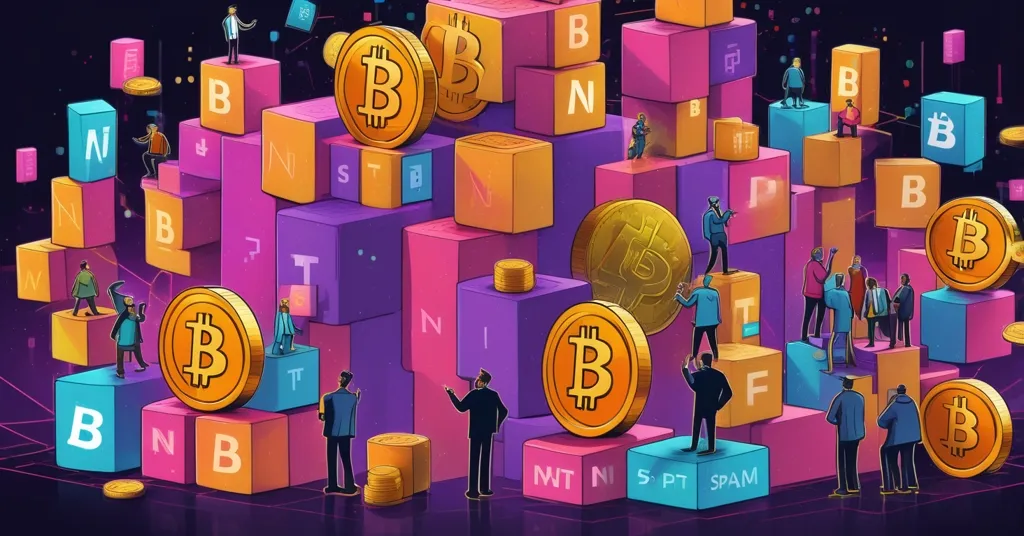Bitcoin Spam Debate: Does Blockchain Bloat Threaten Decentralization?

Bitcoin Spam Debate: Is Blockchain Bloat a Threat to Decentralization?
Bitcoin’s unshakable foundation as decentralized money is under fire in a heated clash over “spam” transactions. Dennis Porter, CEO of the Satoshi Action Fund, has ignited a storm by warning that non-monetary, data-heavy transactions are bloating the blockchain, potentially centralizing power and threatening core principles like the 21 million supply cap. But not everyone agrees, with critics arguing this so-called “spam” is valid and even beneficial. Let’s unpack this battle for Bitcoin’s soul.
- Main Conflict: “Spam” transactions bloat Bitcoin’s blockchain, risking centralization per Dennis Porter.
- Opposing View: Critics defend these transactions as legitimate, supporting miner fees and network neutrality.
- Stakes: The debate questions Bitcoin’s identity as money versus a neutral data layer, with decentralization hanging in the balance.
What Are Spam Transactions, Anyway?
For those new to the fray, “spam” transactions in Bitcoin aren’t your typical email junk. They refer to non-monetary, data-heavy entries on the blockchain—think embedding digital art, memes, or NFTs (non-fungible tokens) rather than sending BTC from one wallet to another. Enabled largely by the Taproot upgrade in November 2021, tools like Ordinals allow users to “inscribe” such data directly onto Bitcoin’s ledger, treating it as a permanent, decentralized storage space. Since early 2023, over 50 million inscriptions have been recorded, pushing the blockchain size past 500 GB and adding roughly 50 GB annually. That’s a hefty load for anyone running a full node—essentially a personal copy of Bitcoin’s entire transaction history that anyone can operate to independently verify the network. Think of full nodes as librarians guarding the ultimate financial record; the bigger the book, the harder their job.
Porter’s Warning: Bloat Leads to Centralization
On August 13, Dennis Porter took to X to sound the alarm. His core argument is that blockchain bloat from spam transactions isn’t just clutter—it’s a creeping danger. As the blockchain grows, so do the storage and bandwidth demands for running a full node. With costs and technical barriers rising, fewer individuals or small entities can afford to participate. Current estimates peg over 15,000 reachable nodes worldwide, but only a fraction are archival (storing the full history) due to resource constraints. Porter fears this shrinkage hands power to a select few—developers, large mining pools, or special interest groups—who could exploit reduced oversight to push through controversial protocol changes, as discussed in his recent posts on X.
“Bloating bitcoin with spam won’t ‘kill’ bitcoin. However, bloating bitcoin with spam WILL allow highly motivated actors to make future changes to bitcoin that undermine its most important principles,” Porter cautioned on X.
Porter goes further, likening full node operators to a “Supreme Court” for Bitcoin—a decentralized check against unchecked power grabs. If node counts dwindle, governance could tilt toward a tiny elite, potentially jeopardizing sacred tenets like the 21 million supply cap (Bitcoin’s hard-coded limit ensuring scarcity) or its censorship resistance (the ability to transact without interference). While there’s no direct technical link between bloat and altering the supply cap, the concern is about governance vulnerability: a centralized network might be easier to manipulate through contentious updates or forks, as highlighted in warnings from experts like Porter himself.
“Node runners are critical stakeholders who act as the ‘Supreme Court’ for Bitcoin. Without a Supreme Court, Congress (developers) can pass whatever laws (rules) they want,” Porter emphasized.
The Counterargument: Spam Is Valid, and Useful
Not everyone’s clutching pearls over blockchain bloat. Pseudonymous Bitcoiner J.Dog fires back, arguing that labeling these transactions as “spam” is a subjective jab at odds with Bitcoin’s core design. Under current consensus rules—the agreed-upon code governing the network—any transaction paying the required fee and fitting protocol standards is valid. Miners aren’t gatekeepers; they process what pays. Trying to filter out “spam” smells like censorship to J.Dog, contradicting the very ethos Bitcoin was built on, a sentiment echoed in broader discussions on platforms like Wikipedia.
“You can’t block spam because they are legitimate transactions,” J.Dog asserted.
There’s a practical upside J.Dog highlights, too. Bitcoin’s security budget—the economic incentive for miners to secure the network—is a looming worry as block rewards halve every four years (the next halving hits in 2024). As rewards shrink, miners increasingly depend on transaction fees. Data from 2023 shows fee spikes driven by inscription hype boosted miner revenue by over 30% during peak periods. J.Dog argues this influx, even from non-monetary transactions, could be a lifeline, ensuring miners have the financial motive to protect the blockchain against attacks.
“There’s also an argument to be made that this is positive for the blockchain because it solves the security budget issue by increasing transactions,” J.Dog pointed out.
Taproot’s Role: A Double-Edged Sword
Much of this debate traces back to the Taproot upgrade, one of Bitcoin’s most significant updates since 2017. Activated in 2021, Taproot introduced Schnorr signatures and MAST (Merkelized Abstract Syntax Trees), enhancing privacy and efficiency for complex transactions. An unintended side effect? It made embedding arbitrary data—like Ordinals inscriptions—far easier and cheaper. While Taproot wasn’t designed to turn Bitcoin into a digital art gallery, it lowered the barriers for such use cases. On one hand, this showcases Bitcoin’s flexibility; on the other, it’s fueled a bloat explosion that maximalists like Porter see as a betrayal of Bitcoin’s monetary mission, a topic explored in depth in this expert analysis on Taproot’s impact.
“It’s not a censorship resistant network for everything. It’s designed to be censorship resistant money. If we make everything censorship resistant then nothing is censorship resistant,” Porter argued, stressing Bitcoin’s original purpose.
Client Diversity and Technical Risks
The spat gets murkier when diving into node software choices. Bitcoin Core, the dominant implementation, powers over 98% of economically significant nodes—those tied to miners and key infrastructure. Porter suggests migrating to Bitcoin Knots, an alternative client offering features like optional spam filtering, without triggering a hard fork (a network split requiring consensus). Critics like Casey (@rodarmor) roll their eyes at this, noting Knots’ negligible economic weight. A bug or divergence in Knots could cause a consensus break, and no one might care if it forks into obscurity, as debated in community threads on Reddit about client diversity.
“It’s going to be so funny when a bug in Knots causes a consensus break and nobody notices when they fork off the network because they’re not economically relevant,” Casey quipped.
Historical Echoes: Satoshi’s Own “Spam”
Adding fuel to the philosophical fire, Erik ₿ points out that Satoshi Nakamoto, Bitcoin’s enigmatic creator, embedded non-monetary data in the very first block in 2009—a headline about bank bailouts. If the founder saw fit to inscribe a message, isn’t data storage part of Bitcoin’s DNA? Porter counters that intent and scale matter. Satoshi’s brief text is peanuts compared to today’s multi-megabyte NFT drops hogging blockspace for pixelated frogs or collectible jpegs.
“Didn’t Satoshi himself add ‘spam’ (as you call it) to the very first block? … Food for thought…” Erik ₿ mused.
The Bigger Picture: Money or Neutrality?
This clash isn’t just about code—it’s a war over Bitcoin’s identity. Is it strictly digital cash, as Porter and many maximalists insist, or a neutral platform where any valid transaction gets a seat, per J.Dog’s camp? This ideological rift harks back to the 2015-2017 block size wars, which birthed forks like Bitcoin Cash over similar debates on scalability versus purity. Compare Bitcoin’s free-for-all blockspace to Ethereum, where sky-high gas fees naturally deter trivial data storage, or layer-2 solutions offload non-critical activity. Bitcoin lacks such built-in filters, leaving the highest bidder—whether remitting life-saving funds or minting a cartoon ape—to claim space. Is this raw neutrality a strength, or a recipe for mission creep?
Centralization: A Real Threat?
Let’s not sugarcoat the risks. Metrics like the Nakamoto Coefficient, which measures how many entities could collude to control 51% of Bitcoin’s network, already show mining power concentrated among a few pools. If full node counts drop further due to bloat, governance could skew even more toward the powerful. This isn’t theoretical—regions with limited bandwidth or hardware access, where running a node is already a privilege, could be priced out entirely, undermining Bitcoin’s promise of financial inclusion. A network guarded by a handful of well-resourced players isn’t the decentralized rebellion we signed up for. But here’s the flip: doesn’t Bitcoin thrive on this tension? A community that brawls over every byte is arguably tougher than one nodding in unison, a concern raised in discussions on Bitcoin’s centralization risks.
Potential Fixes: No Easy Answers
So, what’s the way forward? Proposals are floating, but none are silver bullets. Soft forks to cap inscription sizes or tweak data storage rules (like limiting OP_RETURN outputs) could curb bloat but risk fracturing consensus if users rebel. Optional node filters, as seen in Bitcoin Knots, let operators pick and choose data to store, though they’re a Band-Aid at best without widespread adoption. Then there’s the Ethereum-inspired idea of layer-2 solutions to offload non-critical activity, but Bitcoin’s simplicity makes such complexity a hard sell. Each fix trades one problem for another—less bloat might mean less neutrality, and higher fees could alienate the very users Bitcoin aims to empower. The fee market’s raw chaos might be the least bad option, ugly as it is, and insights on this can be found in community questions on how bloat impacts decentralization.
Calling Out the Hype on Both Sides
Let’s cut through the noise with some no-bullshit clarity. Porter’s claim that bloat could threaten the 21 million cap feels like a stretch—there’s no historical precedent of governance shifts directly altering supply, even during peak centralization scares. It’s fearmongering without a roadmap. On the flip side, inscription cheerleaders claiming fees will “save” Bitcoin’s security budget are peddling hopium. Fee spikes from 2023’s Ordinals craze were tied to speculative bubbles—hardly a stable foundation for miner income. Volatility in fee revenue could leave miners high and dry during lulls. Both sides need to dial down the drama and stick to hard data. Bitcoin’s future isn’t a soap opera; it’s a ledger we’re all accountable to, a perspective reinforced by ongoing controversies surrounding Porter’s views.
Key Takeaways and Questions to Ponder
- What Are Bitcoin Spam Transactions and Why Do They Matter?
These are non-monetary, data-heavy transactions like Ordinals and NFTs embedded on Bitcoin’s blockchain post-Taproot. They matter because they inflate blockchain size, raise node operation costs, and spark debates over Bitcoin’s purpose as money versus a neutral data layer. - How Does Blockchain Bloat Affect Bitcoin’s Decentralization?
Bloat increases resource demands for full nodes, potentially reducing their numbers. Fewer nodes mean less distributed oversight, risking power concentration among developers or large players, which could weaken Bitcoin’s censorship resistance. - Could Spam Transactions Really Impact Bitcoin’s 21 Million Supply Cap?
There’s no direct threat, but Porter warns centralization from bloat could enable a minority to push rule changes, theoretically affecting core principles like the supply cap. This remains a speculative governance risk, not a technical one. - Do Spam Transactions Support Bitcoin’s Long-Term Security?
Potentially, as fees from such transactions boost miner revenue amid dwindling block rewards. However, reliance on speculative fee spikes introduces volatility, and it’s no guaranteed fix for the security budget as halvings continue. - Should Bitcoin Be Censorship-Resistant for Money Only, or All Data?
This is the heart of the divide: purists like Porter prioritize Bitcoin as digital cash, while neutrality advocates defend all valid transactions. The answer shapes whether Bitcoin stays a focused tool or evolves into a broader platform.
Bitcoin’s strength has always been its messy, relentless debates—proof no single voice can hijack its path. Whether bloat is a crisis or a quirk, let’s keep pushing for privacy, freedom, and a financial revolution that spits in the face of gatekeepers. If a few memes or NFTs can derail us, maybe our decentralization is just a shiny collectible after all. The community’s grit, not just its code, will decide what Bitcoin becomes. Let’s make damn sure it stays a middle finger to the status quo.



